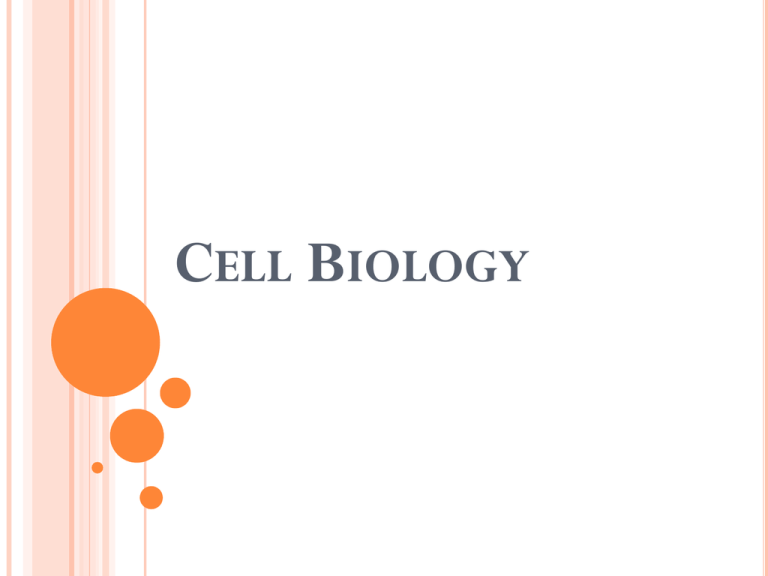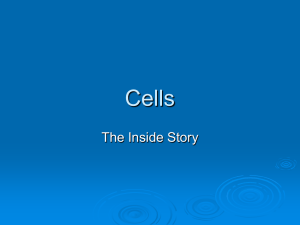Cell Notes 1
advertisement

CELL BIOLOGY TYPES OF MICROSCOPES Microscopes Light Microscope - Uses lenses to magnify up to 1500X TYPES OF MICROSCOPES Electron Microscope - Beam of electrons magnify 500,000X Mosquito Red Blood Cells Bed Bug Head lice THE CELL THEORY - Leewenhoek – 1st microscope Hooke – named cell The Cell Theory 1) Basic unit of structure and organization 2) All organisms composed of cells 3) All cells come from pre-existing cells CELL STRUCTURE All Cells have: an outermost plasma membrane genetic material in the form of DNA cytoplasm with ribosomes CELL STRUCTURE All Cells have: an outermost plasma membrane Structure – phospholipid bilayer with embedded proteins Function – isolates cell contents, controls what gets in and out of the cell, receives signals CELL STRUCTURE All Cells have: genetic material in the form of DNA Eukaryotes – DNA is within a membrane (nucleus) Prokaryotes – no membrane around the DNA (DNA region called nucleoid) CELL STRUCTURE All Cells have: cytoplasm with ribosomes Cytoplasm – fluid area inside outer plasma membrane and outside DNA region Ribosome – site of protein synthesis WHY ARE CELLS SO SMALL? Cells need sufficient surface area to allow adequate transport of nutrients in and wastes out. As cell volume increases, so does the need for the transporting of nutrients and wastes. WHY ARE CELLS SO SMALL? However, as cell volume increases the surface area of the cell does not expand as quickly. If the cell’s volume gets too large it cannot transport enough wastes out or nutrients in. Thus, surface area limits cell volume/size. WHY ARE CELLS SO SMALL? Strategies for increasing surface area, so cell can be larger: “Frilly” edged……. Long and narrow….. Round cells will always be small. CELLS – BASIC UNIT OF LIFE 2 Types of Cells: Prokaryotic – small, simple structure, no nucleus circular DNA and ribosomes bacteria Eukaryotic – complex, large structure WITH nucleus many membrane bound organelles including nucleus Plant, animal, protist, and fungi cells PROKARYOTIC CELL STRUCTURE Structures Plasma membrane Cell wall Cytoplasm with ribosomes Nucleoid Capsule* Flagella* and pili* *present in some, but not all prokaryotic cells PROKARYOTIC CELL TEM Prokaryotic Cell EUKARYOTIC CELLS Structures in all eukaryotic cells Nucleus Ribosomes Endomembrane System Endoplasmic reticulum – smooth and rough Golgi apparatus Vesicles Mitochondria Cytoskeleton TYPES OF EUKARYOTIC CELLS What are noticeable differences in the plant and animal cells? Plant Cells Cell wall Chloroplast Large vacuoles Animal Cells Centrioles Small vacuoles NUCLEUS CYTOSKELETON RIBOSOMES MITOCHONDRION ROUGH ER SMOOTH ER CENTRIOLES GOLGI BODY PLASMA MEMBRANE LYSOSOME Fig. 4-15b, p.59 CELLULAR ORGANELLES Nucleus Cytoplasm Mitochondria Lysosomes Ribosomes Vacuoles Golgi apparatus Centrioles Chloroplasts Cilia/flagellum Endoplasmic reticulum (ER) Rough and smooth HOW DOES YOUR ORGANELLE CONNECT TO OTHERS? Your Organelle Works with organelle #1 Works with organelle #2 Works with organelle #3 SPECIALIZED CELLS Name the one human cell with a flagella. Why does it need a flagella? Why would liver cells contain a high amount of lysosomes? Why would heart cells contain a high amount of mitochondria? How does the chloroplast work with the mitochondria in plant cells? ORGANELLE FUNCTIONS – CELLULAR RESPIRATION Mitochondria Highly folded inner membrane Takes oxygen and glucose – makes ATP Oxygen – picked up in the lungs Glucose – broken down from digested food C6H12O6 + O2 CO2 + H2O + ATP O2 C6H12O6 H2O CO2 FERMENTATION Occurs after glycolysis when no O2 for Citric Acid Cycle Attempt by body to still create energy Creates lactic acid as by product in animal cells Alcoholic fermentation – yeast cells THE BIG PICTURE RESPIRATION You eat foods that are broken down into glucose Glucose converts to energy in the mitochondria The process is most effective in the presence of oxygen The body needs energy to function Carbon dioxide is produced during the process – as a waste product COMPARISON OF FERMENTATION TO RESPIRATION Lactic Acid Glucose (no O2) Alcoholi c (no O2) Cellular Respiration (O2) Glucose Glucose Lactic acid Glycolysis Glycolysis Glycolysis Carbon dioxide Carbon dioxide Alcohol H2 O 2 ATP 2 ATP 38 ATP ADP ATP Energy Adenosine diphosphate (ADP) + Phosphate Partially charged battery Energy Adenosine triphosphate (ATP) Fully charged battery ORGANELLE FUNCTION PHOTOSYNTHESIS Chloroplast Uses suns energy to create glucose Glucose created then goes through respiration to create ATP sun 6CO2 + 6H20 C6H12O6 + 602 Sugar STEPS OF PHOTOSYNTHESIS Light dependent reactions Chlorophyll captures light Series of steps Light independent reactions Uses CO2 to make sugar THE BIG PICTURE PHOTOSYNTHESIS Plants capture sun rays on their leaves Plants convert sun rays to glucose in the chloroplast That glucose then goes through respiration in the plants mitochondria Plants production of glucose produces oxygen as a waste product ENERGY Why is the sun considered the ultimate source of all energy? What would occur to a human cell that contained no mitochondria? Could a plant cell survive without mitochondria? Why do cells need energy? CREATE… Your lab group will create and present a product that represents the connection between photosynthesis and cellular respiration. You may create a: Poster Song/Rap Poem/Story Other – must be approved by me!









